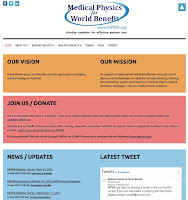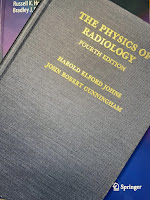I’ve found the perfect book for readers of
Intermediate Physics for Medicine and Biology who are fascinated by
medical physics but who don’t want a lot of technical details and math.
Jacob Van Dyk recently published
True Tales of Medical Physics: Insights into a Life-Saving Specialty. The book consists of 22 chapters written by leading medical physicists, in which they each discuss their career, focusing on interesting anecdotes and life lessons. If I were a young student pondering what career to pursue, this is a book I’d want to read.
Van Dyk’s instructions to the contributors were
to communicate what medical physics is and what medical physicists do to a broad audience including science students, graduate students and residents, experienced medical physicists and their family members, and the general public who are wondering about medical physics.
The book will consist of a series of short stories written by award-winning medical physicists—stories that are of personal interest as it relates to their careers. Each story will be unique to the author and could serve any one or more of the following purposes:
- Be an inspiration to young people searching for career directions, as well as more experienced physicists who are seeking direction on leadership development.
- Provide an overview of what medical physicists do with a level of description that is understandable by the non-medical physicist.
- Provide lessons on life’s experiences from high-profile medical physicists who have significant experience and who are clearly at the top of the field as shown by the awards that they have won.
- Be entertaining for those working in the field as well as others.
You can look at this book as a
Plutarchian collection of comparative biographies, or you can focus on cross-cutting lessons that appear again and again in the various chapters. Here are some of the lessons I noticed.
-
The critical role of mentoring. All the authors stressed the importance of having supportive, inspirational mentors early in their career, and the satisfaction of mentoring their own students.
-
Crucial advances grow out of discussions at scientific meetings. Clearly the opportunity to travel and attend meetings is a part of a scientist’s career that’s highly valued, and often leads to new research directions and collaborations.
-
The division of their duties into three parts: research, teaching, and clinical work. The variety that arises from having these three different tasks keeps a medical physicist’s job from ever becoming dull or routine.
-
Leading scientific societies. The American Association of Physicists in Medicine (AAPM), the American Society for Radiation Oncology (ASTRO), the International Organization for Medical Physics (IOMP), and others professional groups are mentioned over and over by these authors.
-
The challenge of the American Board of Radiology (ABR) exams. Today, these certification exams act as a gateway to a career in clinical medical physics.
-
The interdisciplinary nature of medical physics. Many of these authors brought expertise from one field (say, computer programming) and integrated that knowledge with other fields (say, anatomy or medical imaging).
- Failures are opportunities. These scientists had their share of setbacks, but managed to overcome them and use them as springboards to success. They persisted.
-
The role of industry in medical physics research. Many authors tell stories of interacting with for-profit companies making imaging or therapy devices. Working with industry can be complicated and aggravating, but when successful the resulting products can have a huge impact on medical practice.
- Science is an international activity. Many authors had collaborators and students from all over the world, leading to lifelong friendships.
True Tales of Medical Physics illustrates what a career in medical physics is like better than any textbook can (even
IPMB!). Some of the authors worked on old, now obsolete devices—
colbalt-60 radiation therapy, the
betatron,
film/screen cassettes—but they also helped develop today’s cutting edge technologies:
computed tomography (CT),
intensity-modulated radiation therapy (IMRT),
magnetic resonance imaging (MRI), and
medical ultrasound (US). These authors worked at leading medical institutions, such as the
Memorial Sloan Kettering Cancer Center and the
MD Anderson Cancer Center. Many were included in the IOMP’s 50th anniversary list of
50 medical physicists who have made an outstanding contribution to the advancement of medical physics over the last 50 years (I can’t help but compare this to the
list of the 50 greatest basketball players prepared by the
National Basketball Association on their 50th anniversary).
While I enjoyed all the chapters in
True Tales, my favorite was by
Marcel van Herk, a
Steve Wozniak-like Dutch electronics guru. He started out as a 12-year-old hobbyist who built his own computer.
Van Herk writes “One of the first things I did was to design and build a completely functional relay-based
full adder (a circuit that can add two 4-
bit binary numbers),
soldered together while listening to
Black Sabbath’s
Iron Man in the living room, not totally to my mother’s liking due to the music and the spilled solder on the carpet. The parts I used were small electromechanical
relays from 1950
punched card sorting machines, acquired cheaply.” He ended up developing software for the
Elekta cone-beam CT imaging guidance system integrated with a medical
linear accelerator. While his story is fascinating, it’s not uncommon; many of these scientists traveled individual, meandering paths into medical physics, taking them from a clueless neophyte to a giant in their field. A key lesson for students is that there’s no single route to success in science, and certainly not in medical physics.
If you are considering possible careers, I urge you to read
True Tale of Medical Physics. It may change your life. You may change medicine.








